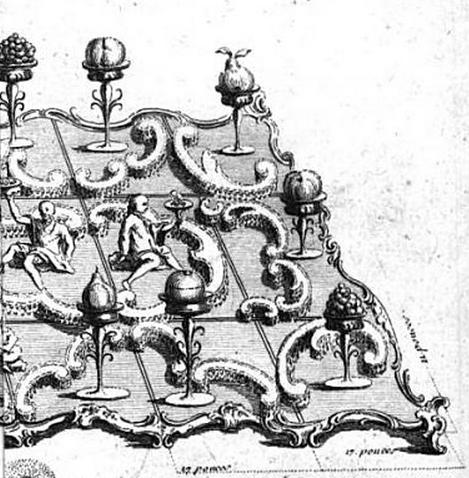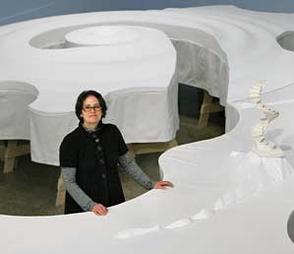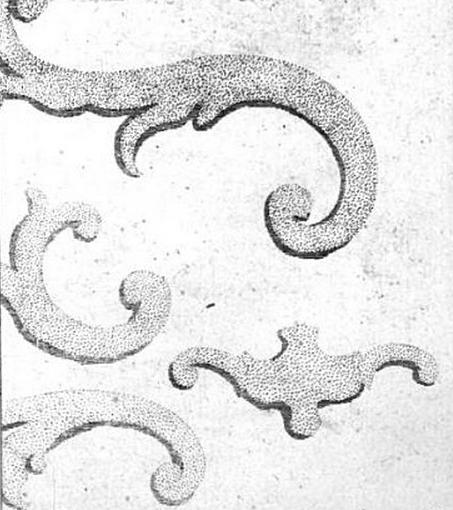As a blogger who is curious about all things in Jane Austen’s world and customs in her past that might have influenced her, I am still amazed at how one tiny clue points to another until I land on a series of sites that open up a whole new topic. While history foodies probably know about the elaborate lengths that pastry chefs took to please their patrons, the visual results of a full banquet are simply astounding. I can only assume that Georgian taste buds were equally pleased.

Modern chef and historian, Ivan Day, recreated a feast from the past using sugar structures and porcelain figures to arrange a fanciful garden centerpieces for the table.
I already knew about The Prince Regent’s elaborate 1811 dinner at Carlton House, which was described as thus:
“Along the centre of the table about six inches above the surface, a canal of pure water continued flowing from a silver fountain beautifully constructed at the head of the table. Its banks were covered with green moss aquatic flowers; gold and silver fish swam and sported through the bubbling current, which produced a pleasing murmur where it fell, and formed a cascade at the outlet.” – The Gentleman’s Magazine, describing the Prince Regent’s fete at Carlton House, June 19, 1811 in honor of the exiled French royal family.

The great kitchen at the Prince Regent’s Pavilion at Brighton could accommodate creating dishes for huge and fanciful banquets.
So great was the interest that the doors of Carlton House were opened for three days in a row. But instead of satisfying the curiosity of the masses, the result was ever-increasing crowds. Chaos ensued.
‘The condescension of the Prince in extending the permission to view the arrangements for the late fete at Carlton House has nearly been attended with fatal consequences,’ reported one newspaper. Read more: http://www.dailymail.co.uk/news/article-1039063/As-Queen-opens-Palace-Ballroom-public-story-decadent-royal-banquet-ever.html#ixzz1s7ijkAEv

Detail of the design for an elaborate garden centerpiece. These engravings were showcased in Le Cannameliste Français by famed confectionary chef, Joseph Gilliers, in the mid-18th century. View the entire centerpiece here: Click on this link.
The banquet featured a recreation of a landscape at its center. Such a method of decorating a table was not new, especially when it came to desserts. Elaborate set pieces with architectural French influence were created for tables using spun sugar and Sevres bisque figures to create fantasy landscapes. Before the Napoleonic Wars, travel over the English Channel between British and French courtiers and diplomats was common, and thus the French chef’s custom of creating these elaborate centerpieces became well-known in England. Upper class households vied for highly paid (and desired) French chefs, and by the 1820s these gentlemen had by and large invaded British upper class kitchens. Their ability to create dishes that feasted both the eyes and the stomach was unrivaled.
This was an era when confectionary was considered as much a branch of the decorative arts as of cuisine, and porcelain for the table represented prestige as well as a demonstration of power. The combination of French chef, porcelain, and fanciful confectionary desserts served as symbols of prestige and wealth, for no ordinary household could offer such an extravagant display of food and panoply. (View this porcelain table centerpiece set.)
Most of the images of the banquets and figurines are copyrighted. I encourage you to click on the links to view the spectacular results of sugar and porcelain table centerpieces that mimic gardens, sculptures, and figures based on famous paintings. The fanciful recreation included redesigning tables as well.

Amy Hauft, VCU sculpture department. Confectioner Joseph Gilliers conceived his 100-seat rococo fantasy for the serving of a single course — dessert — in a garden setting. The centerpiece atop the tailored white tablecloth was to be a sculpture made of sugar paste fortified with dried sturgeon bladder. There is no record that this table was ever built by Gilliers. Image@Richmond Times Dispatch
More on this fascinating topic:
- Ivan Day, who oversees the Historic Food website and Food History Jottings blogs, is a modern-day chef who recreates sumptuous food from the past. His post on Edible Artistry is to die for.
- Le Cannameliste Francais, Joseph Gilliers, 1768
- Sugar Sculpture, Porcelain and Table Layout 1530-1830, Howard Coutts and Ivan Day
- A Feast for the Eyes
- Regency Excess At Atthingham
- Just Desserts.
- Eye Candy: The Magazine Antiques
- Ivan Day: Regency Dining
- At Table: High Style in the 18th Century
- A Scene of Sugar Fit for a Table of Yore
- The Great Kitchen at the Brighton Pavilion
- Metropolitan Museum: LeCannameliste Français, Ou Nouvelle Instruction Pour Ceux Qui Desirent D’Apprendre L’Office, Rédigé en Forme de Dictionnaire, Written by Joseph Gilliers (French, died 1758)
- Bisque lions
- Banquet Coronation of George IV, Culture 24, Parliament Week
- Sweet Structures: Art & Architecture Made of Sugar
- Sweet Invention, A History of Dessert, Michael Krondl
- Click here to view a painting by Luke Clennell of a banquet in honor of the Prince Regent.
- Carpe Diem!
- Recreating a rococo fantasy
- Click here to see more of Gilliers’ illustrations.













Hi, the sugar baldichino you illustrate at the bottom of the page is not made from spun sugar, nor is it based on a design by Gilliers. I made two of them from pastillage sugar paste for an exhibition at the Met in NYC two years ago and set the table there. They were exact replicas of ones made for Maria Theresa, the Empress of Austria in 1740. You can see the source for them on this page on my website –
http://www.historicfood.com/events2010-11.htm and scroll down.
best regards
Ivan Day
Your best blog *EVER*! Thanks so much!
Gorgeous. I have The Jane Austen Cookbook, which is more concerned with daily dining, but there are some nods to this fabulous habit of the truly fashionable and wealthy. (I would not have wanted to be a drudge in one of those kitchens…one can only imagine the chef’s tantrums!! :-) )
What an amazing table! A spiral seems a fantastic way of getting a lot of people seated close together, but I imagine you would all have to get in and out in order! Heaven help you if you needed the toilet!
Your photographs are quite delicious! ;-) They really capture the look of a table from Jane Austen’s time.
Those sugar sculptures have a long history, and are the ancestors of all the porcelain figurines which are still popular today. When hard-paste porcelain was discovered in Meissen in the early eighteenth century, they began making dinner services, initially just plates and other serving dishes. But soon, they also made porcelain copies of the many sugar sculptures which had been popular for decades. It was thought that attractive scenes set up on the table at dessert was good for the digestion.
It was actually during the Regency that hordes of those porcelain table sculptures escaped from the dessert table, as many people thought them too attractive to be seen only during the last course of a meal.
Thank you for both the eye-candy and the information.
Regards,
Kat
This sort of thing has a long history. I am not an expert but I know of medieval “subleties” that were the same sort of thing, although they were usually not used as centerpieces, I believe.
Since I put on quite a few “teas” and lecture on the style of living during the Austen period, I found this extremely informative and well as enjoyable. Thank you for the research and sharing.
Absolutely gorgeous! I can’t even make the food on my plate look decorative. I’d love to see a table decorated like this in real life. These pics are amazing so the real this has to be unbelievably incredible.
Vic, an interesting post. I had no idea that such detail was taken in what I would think of as a nice, pretty thing today. But, I would imagine that a lot of hostesses were competing with each other for who had the best table laid out. I understand that the French chefs were highly sought after and hostesses also bragged about their French chef, especially when they had lured one away from another kitchen. Do I have this correct?
Oh, wow! It never fails to amaze me how much they pigged out. Our appetites have considerably lessened with time. Perhaps with food becoming cheaper, it is no longer interesting to flaunt food as a social status. Nice post.